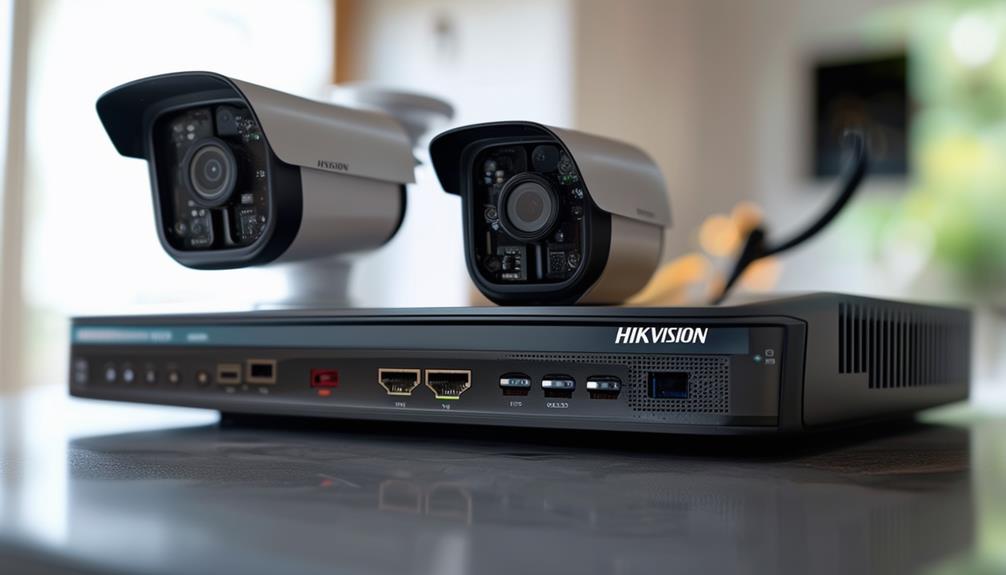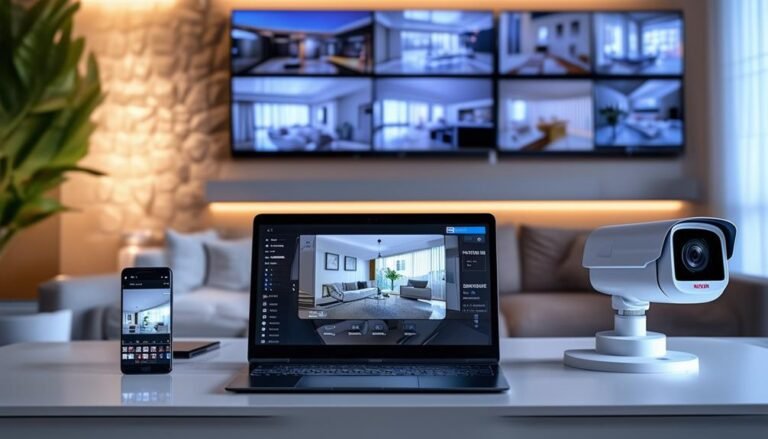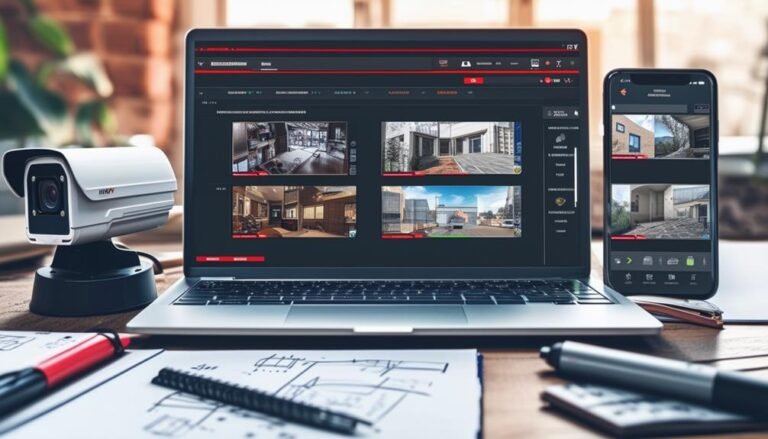Yes, you can definitely add IP cameras to your Hikvision DVR. This integration enhances your surveillance capabilities by providing higher resolution feeds and remote access options. Just make sure the cameras are compatible, ideally supporting ONVIF or Hikvision’s protocol. You’ll need to connect the camera to the same network as your DVR and configure the settings accordingly. Don’t forget to keep your firmware updated for smoother operation. If you follow the right steps for setup and configuration, you’ll be well on your way to an improved security system. There’s more useful info waiting for you on this topic!
Understanding Hikvision DVRs
When you’re setting up a surveillance system, understanding Hikvision DVRs is essential. These Digital Video Recorders are the backbone of your security setup, allowing you to capture, store, and manage video footage from your cameras. With a Hikvision DVR, you gain control over your own security, ensuring you’re always informed about what’s happening around you.
One key feature of Hikvision DVRs is their compatibility with various types of cameras, enabling you to customize your system to meet your specific needs. You’ll find models that can support both analog and IP cameras, giving you flexibility in choosing the right equipment. This adaptability is vital for those who value freedom in surveillance; you can expand your system as your needs grow.
Navigating the user interface of a Hikvision DVR is straightforward, making it easier for you to set up and manage your recordings. The system typically includes options for motion detection, scheduled recordings, and remote viewing, allowing you to monitor your property from virtually anywhere. This kind of accessibility empowers you, giving you peace of mind that you’re in control.
Moreover, Hikvision DVRs often come with robust security features, including user management and encryption, ensuring that your footage remains private and secure. By understanding these DVRs, you’re not just investing in technology; you’re investing in your autonomy and the safety of your space. With the right knowledge, you can effectively tailor your surveillance system to protect what matters most.
Types of IP Cameras
Choosing the right IP camera is key to maximizing the potential of your Hikvision DVR. With various types of IP cameras available, understanding your options can empower you to make the best choice for your surveillance needs.
First off, there are dome cameras, which are popular for their discreet design and wide-angle views. They’re perfect for both indoor and outdoor use, offering a sense of security without being overly obtrusive. If you want flexibility, consider PTZ (pan-tilt-zoom) cameras. These allow you to remotely control the direction and zoom level, giving you dynamic coverage of larger areas.
Next, bullet cameras are another option, known for their long-range capabilities. If you’ve got a specific area you want to monitor closely, bullet cameras are ideal for focused surveillance. On the other hand, if you’re looking for something that can withstand harsh weather conditions, go for an outdoor-rated camera. These are built to endure elements like rain, snow, and extreme temperatures.
Lastly, there are fisheye cameras, which provide a 360-degree view without any blind spots. They’re fantastic for monitoring large spaces like warehouses or parking lots. Whatever your needs are, knowing the different types of IP cameras gives you the freedom to tailor your surveillance system to fit your lifestyle. So, take the time to evaluate your options – it’s an investment in your security and peace of mind.
Compatibility Considerations
Before adding an IP camera to your Hikvision DVR, it’s important to check compatibility. You don’t want to invest your time and money only to find that your new camera won’t work with your existing system. Start by confirming that both devices support the same protocols. Hikvision DVRs typically work best with cameras that use the ONVIF or Hikvision’s proprietary protocol. If your camera doesn’t support these, it might be a challenge to integrate it.
Next, consider the resolution and frame rate of the IP camera. The DVR should be capable of handling the camera’s specifications without overloading its processing capabilities. If you’re planning to mix and match different camera brands, verify that the resolutions are consistent; otherwise, you could end up with uneven video quality across your system.
Also, think about the number of channels your DVR supports. If you’re planning to add multiple IP cameras, make certain your DVR can handle the extra load. Each camera will consume bandwidth and processing power, so don’t exceed the channel limits.
Lastly, check the firmware version of your DVR. Sometimes, compatibility can be affected by outdated software. Confirm your DVR is running the latest firmware for the best chance of seamless integration. By taking these considerations into account, you can enjoy the freedom of customizing your security setup without the hassle of compatibility issues.
Required Equipment
To successfully add an IP camera to your Hikvision DVR, you’ll need some specific equipment. This includes compatible camera types, the right cables and connectors, and an understanding of your network configuration. Getting these components sorted out will guarantee a smooth setup process.
Compatible IP Camera Types
Compatibility is essential when adding an IP camera to a Hikvision DVR, as not all cameras will seamlessly integrate with the system. To guarantee a smooth setup, you’ll want to focus on cameras that are either Hikvision-branded or those that support the ONVIF standard. Hikvision’s own cameras are inherently compatible, allowing for easy configuration and reliable performance.
If you’re considering third-party options, look for IP cameras that explicitly state ONVIF compliance. This protocol promotes interoperability among different security devices, giving you the freedom to choose from a wider range of brands and models.
When selecting a camera, also pay attention to the resolution and image quality. Hikvision DVRs can handle various resolutions, but opting for cameras with similar specs will yield the best results.
Lastly, don’t forget that the camera’s features, such as night vision or motion detection, should align with your surveillance needs. By keeping these aspects in mind, you can confidently expand your security system, guaranteeing that everything works together harmoniously.
Necessary Cables and Connectors
When setting up an IP camera with your Hikvision DVR, having the right cables and connectors is essential for a successful installation. You’ll want to guarantee that everything connects smoothly, allowing you the freedom to monitor your space without any hitches.
Here’s a quick overview of what you’ll need:
| Cable/Connector | Purpose |
|---|---|
| Ethernet Cable | Connects IP camera to the network |
| PoE Injector/Switch | Supplies power and data via Ethernet |
| BNC Connector | For coaxial video connections (if applicable) |
| Power Adapter | Provides power to the camera if not using PoE |
| Extension Cable | Extends reach for camera placement |
With these components, you’ll be well-equipped to set up your system. Make sure to choose high-quality cables to avoid any signal loss. Whether you’re running cables through walls or along surfaces, a little planning can go a long way. Embrace the journey of setting up your security system, and enjoy the peace of mind that comes with it!
Network Configuration Requirements
After gathering the necessary cables and connectors, you’ll need to focus on your network configuration requirements to confirm everything works seamlessly. First off, make sure your IP camera and Hikvision DVR are on the same local network. This typically means connecting both devices to the same router or switch. You’ll also want a stable internet connection, especially if you plan to access your camera remotely.
Next, you’ll need to assign IP addresses. You can do this manually or enable DHCP on your router, which automatically assigns IP addresses. Just confirm that the IP address of your camera doesn’t conflict with the DVR’s address.
You’ll also want to check your subnet mask and default gateway; these should match between your devices to communicate effectively. Finally, consider enabling Port Forwarding on your router if you plan on accessing your system from outside your local network.
Network Configuration Steps
To successfully configure your network for the IP camera and Hikvision DVR, you’ll need to follow a series of straightforward steps. First, verify both your DVR and IP camera are connected to the same network. This typically involves connecting them to the same router using Ethernet cables or confirming they’re on the same Wi-Fi network if they’re wireless.
Next, access the DVR’s interface by typing its IP address into a web browser. Log in using your credentials. Once you’re in, navigate to the network settings section. Here, check the IP address of your DVR and make a note of it. You’ll want your IP camera to have a unique IP address on the same subnet; this means it should start with the same numbers as your DVR but have a different last number.
Now, connect to your IP camera’s web interface, often done by entering its default IP address in a browser. Log in and change its IP address to match the subnet of your DVR. Set the gateway to your router’s IP address, and save your changes.
After that, you might need to adjust some firewall settings on your router to verify the camera can communicate freely with the DVR. Finally, reboot both devices to verify the settings take effect. This setup allows for seamless communication between your Hikvision DVR and the IP camera, giving you the freedom to monitor your space effectively.
Adding the IP Camera
Now that you’ve set up your network, it’s time to add your IP camera to the Hikvision DVR. First, you’ll want to check the compatibility requirements to guarantee everything works smoothly. Once that’s sorted, we can go through the configuration steps and some troubleshooting tips if you run into any issues.
Compatibility Requirements
When considering the addition of an IP camera to your Hikvision DVR, it’s crucial to guarantee compatibility between the devices. This makes sure you get the most out of your surveillance setup without any hiccups. Here are some key aspects to check for compatibility:
- Camera Type: Make sure your IP camera is either ONVIF-compliant or specifically designed to work with Hikvision systems.
- Firmware Version: Check that your DVR’s firmware is up to date. Older versions may not support newer IP camera models.
- Resolution Support: Confirm that the camera’s resolution aligns with what your DVR can handle. Higher resolution cameras may require more bandwidth.
- Network Connection: Verify that both devices can connect to the same network, whether wired or wireless.
- Power Supply: Ensure that your IP camera’s power requirements match what your setup can provide, especially if using PoE (Power over Ethernet).
Configuration Steps
After confirming compatibility between your IP camera and Hikvision DVR, the next step is to configure the camera for seamless integration. First, connect your IP camera to the same network as your DVR. You can do this via Ethernet or Wi-Fi, depending on your camera’s capabilities.
Next, access your DVR’s interface. You can usually do this by entering its IP address in a web browser. Log in with your credentials. Once inside, navigate to the “Camera” or “Add Camera” section. Here, select the option to add an IP camera.
You’ll need to input your camera’s details, including the IP address, port number, and login credentials. Be certain the settings match your camera’s configuration. After entering the required information, click “Add” or “OK.”
Once added, you should see the camera listed in the DVR’s camera management section. It’s a good idea to test the camera feed to verify everything’s working smoothly. Adjust settings as needed to fit your surveillance needs. Now you’ve successfully integrated your IP camera, giving you that sense of freedom and control you’ve been aiming for!
Troubleshooting Tips
Even if you’ve followed all the configuration steps, you might still encounter issues while adding your IP camera to the Hikvision DVR. Don’t worry; you can troubleshoot these problems effectively. Here are some tips to get you back on track:
- Check Network Connectivity: Verify both your DVR and IP camera are on the same network.
- IP Address Conflict: Make sure there are no duplicate IP addresses on your network.
- Firmware Updates: Validate that both your DVR and camera have the latest firmware updates installed.
- Correct Protocol: Confirm you’re using the right protocol settings (like HTTP or RTSP).
- Power Cycle Devices: Sometimes, simply restarting the DVR or camera can resolve connectivity issues.
Configuring Camera Settings
Configuring camera settings is essential for ensuring ideal performance and security in your surveillance system. You want to make sure your IP camera is set up just right so you can capture everything important without missing a beat. Start by accessing the camera’s interface through your Hikvision DVR. You’ll typically do this by entering the camera’s IP address in your web browser.
Once you’re in, adjust the resolution settings to meet your needs. Higher resolutions offer better clarity but can use more bandwidth. If you’re looking for a balance, consider a 1080p setting. Next, tweak the frame rate; this controls how many frames the camera captures per second. A higher frame rate is great for fast-moving scenes, while a lower rate can conserve bandwidth for stationary areas.
Don’t forget about the brightness and contrast settings. You can adjust these based on the lighting conditions of your area. For nighttime surveillance, enable infrared settings if your camera supports it, ensuring clear images even in low light.
Additionally, consider setting motion detection zones to avoid unnecessary alerts from passing cars or branches swaying in the wind. This way, you’ll only get notifications when something truly matters.
Testing the Setup
Now that you’ve configured your camera settings, it’s time to test your setup. First, you’ll want to verify the camera’s compatibility with your Hikvision DVR and guarantee that the network settings are correctly configured. This step is essential for making sure everything works smoothly together.
Verify Camera Compatibility
To guarantee your IP camera works seamlessly with the Hikvision DVR, it’s crucial to verify compatibility before finalizing your setup. This step can save you time, money, and frustration down the line. Here’s what you should check:
- Camera Resolution: Confirm the IP camera’s resolution matches what your DVR supports.
- Protocol Support: Verify the camera uses the same protocol (like ONVIF or RTSP) as your DVR.
- Power Requirements: Check if the camera needs PoE (Power over Ethernet) or a separate power source.
- Firmware Updates: Ensure both your camera and DVR have the latest firmware updates to avoid compatibility issues.
- Brand and Model: Research if your specific camera model is known to work with Hikvision DVRs.
Taking the time to verify these factors will give you peace of mind and guarantee a smooth installation. Once you’ve confirmed compatibility, you’ll be one step closer to enjoying the freedom of a fully integrated security system. So don’t skip this crucial check—it’s worth the effort!
Configure Network Settings
Setting up network settings for your IP camera is essential for creating a reliable security system. First, connect your camera to the same network as your Hikvision DVR. Once that’s done, log into your DVR interface. Navigate to the network settings section where you’ll find options to add cameras. You’ll need the camera’s IP address and other details, which you can usually find on the camera’s documentation or through your router’s connected devices list.
Next, input the camera’s information into the DVR. Be certain to match the subnet mask and gateway settings to avoid connectivity issues. After you’ve entered all necessary details, save the settings and reboot the DVR.
To test your setup, go back to the camera management section of the DVR. If everything’s configured correctly, you should see a live feed from your camera. If it’s not showing up, double-check the IP address, verify the camera is powered on, and confirm that it’s connected to the network. With these steps, you can enjoy a seamless security experience, freeing you from worries about your safety.
Troubleshooting Common Issues
When connecting an IP camera to a Hikvision DVR, you might encounter various issues that can disrupt the setup process. Don’t worry; troubleshooting these common problems is often straightforward. Here are some issues you may face:
- Network Configuration: Incorrect IP addresses or subnet masks can prevent communication.
- Camera Compatibility: Not all IP cameras work seamlessly with Hikvision DVRs.
- Power Supply: Confirm your camera is receiving adequate power; a lack of it can cause connectivity issues.
- Firmware Mismatch: Outdated firmware on either the camera or DVR can lead to functionality problems.
- Port Forwarding Issues: If you’re accessing the camera remotely, incorrect port forwarding settings can block access.
To tackle these issues, start by checking your network settings. Verify that your camera and DVR are on the same subnet. If the IP camera isn’t showing up, try rebooting both devices. It’s also wise to confirm that the camera is compatible with your Hikvision DVR model.
If you suspect a power issue, confirm that your camera is plugged into a reliable power source. For firmware-related issues, check the manufacturer’s website for updates and install them as needed. Finally, for remote access, review your router’s port forwarding settings to confirm they’re correct.
With these troubleshooting steps, you’ll be well on your way to successfully integrating your IP camera into your Hikvision DVR setup. Don’t hesitate to reach out to support if you’re still having trouble!
Benefits of Integration
Integrating an IP camera with your Hikvision DVR not only enhances your surveillance capabilities but also streamlines your security management. This combination allows you to enjoy several benefits that can empower your approach to safety and freedom. Here’s how this integration can work in your favor:
| Benefit | Description | Impact |
|---|---|---|
| Improved Resolution | IP cameras often offer higher resolutions, providing clearer images. | You’ll see finer details, enhancing identification. |
| Remote Access | You can access your system from anywhere using a smartphone or computer. | This freedom lets you monitor your property on-the-go. |
| Flexible Installation | IP cameras can be installed in various locations without extensive wiring. | You’re not limited to fixed locations, maximizing coverage. |
| Scalability | Easily add more cameras as your needs grow without significant upgrades. | You can expand your system without stress. |
Frequently Asked Questions
Can I Mix Different Brands of IP Cameras With My Hikvision DVR?
You might be wondering if you can mix different brands of IP cameras with your Hikvision DVR. While it’s possible to connect them, compatibility isn’t guaranteed. It’s best to check if the cameras support the same protocols, like ONVIF. If they do, you should have a decent chance of them working together. Just keep in mind that using different brands could lead to some features not functioning as expected.
How Many IP Cameras Can I Connect to One Hikvision DVR?
When you’re setting up your surveillance system, it’s essential to know how many IP cameras you can connect to your Hikvision DVR. For instance, if you decide to monitor both your front yard and backyard, you can typically connect up to 16 IP cameras, depending on your DVR model. This flexibility lets you create an extensive security network, ensuring your property feels safe and secure. So, you can customize your setup to fit your needs!
Will Adding IP Cameras Affect My Dvr’s Recording Quality?
Adding IP cameras can affect your DVR’s recording quality, but it depends on several factors. If your DVR has enough bandwidth and processing power, you may not notice a difference. However, overloading it with too many cameras can lead to reduced frame rates or lower resolution recordings. It’s crucial to balance the number of cameras with your system’s capabilities to maintain the quality you desire. So, keep an eye on your system’s performance!
Can I Access My IP Camera Remotely Through the Hikvision DVR?
Imagine being able to check your home’s security anytime, anywhere. Yes, you can access your IP camera remotely through your Hikvision DVR. It’s like having your own virtual watchtower, offering you peace of mind. You’ll just need to set up the appropriate settings, ensuring your DVR is connected to the internet. Once that’s done, you’re free to monitor your space from your smartphone or laptop, no matter where you are.
Do I Need a Specific Firmware Version for Compatibility?
You’ll definitely want to check the firmware version of your device for compatibility with your IP camera. If it’s outdated, you might run into issues. Hikvision often updates their firmware to enhance features and fix bugs, so keeping yours current is a smart move. It’s all about ensuring you have the best performance and integration. Don’t hesitate to refer to the user manual for specific firmware requirements related to your camera model.



